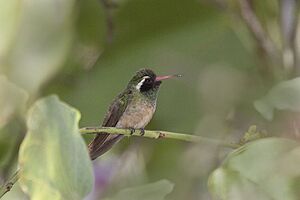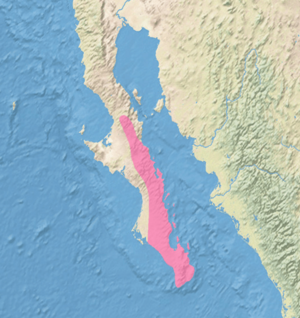Xantus's hummingbird facts for kids
Quick facts for kids Xantus's hummingbird |
|
|---|---|
 |
|
| Conservation status | |
| Scientific classification | |
| Genus: |
Basilinna
|
| Species: |
xantusii
|
 |
|
| Range of Xantus's hummingbird | |
| Synonyms | |
|
Hylocharis xantusii |
|
The Xantus's hummingbird (Basilinna xantusii) is a small, colorful bird. It was once called the black-fronted hummingbird. This amazing bird lives only in the Baja California Peninsula in Mexico. It belongs to a group of hummingbirds known as "emeralds."
About Xantus's Hummingbird
What's in a Name?
This hummingbird is named after John Xantus de Vesey. He was a Hungarian zoologist who first found and collected one of these birds. Scientists first put this hummingbird in the Basilinna group. Later, they moved it to the Hylocharis group. But in the early 2000s, they decided it belonged back in the Basilinna group. The Xantus's hummingbird is the only other bird in this group besides the white-eared hummingbird.
How to Spot a Xantus's Hummingbird
Xantus's hummingbirds are about 8.5 to 9.5 centimeters (3.3 to 3.7 inches) long. Males weigh about 3.5 grams (0.12 ounces). Females are a tiny bit lighter at 3.4 grams (0.12 ounces). Their beaks are straight and about 1.7 centimeters (0.67 inches) long.
Male Hummingbirds
Male Xantus's hummingbirds have bright colors. Their beaks are red with a black tip. Their heads and backs are a shiny golden green or emerald green. They have a black forehead and chin. A wide white stripe goes behind their eye. Their throat is a sparkling emerald green. Their bellies are cinnamon-colored. Their tail feathers are a reddish-brown color.
Female Hummingbirds
Female Xantus's hummingbirds look a bit different. Their faces are brownish-black. They have a pale, light brown stripe behind their eye. Their backs are a shiny golden green. Their throats and bellies are a light to medium cinnamon color. Their tail feathers are dark reddish-brown with thin white tips.
Where They Live
Home Sweet Home
Xantus's hummingbirds live in the central and southern parts of the Baja California Peninsula. Sometimes, they fly far away from home. They have been seen in California and even British Columbia, Canada!
Their Favorite Places
These hummingbirds like dry woodlands. They live in areas with scrub bushes, oak trees, and pine-oak forests. They can be found at elevations from 150 to 1500 meters (490 to 4,900 feet) high. They also visit gardens and bird feeders near the coast.
Hummingbird Habits
Moving Around
Scientists are still learning about how Xantus's hummingbirds move. They nest in mountain forests. After their babies leave the nest, they often fly down to sea level. They might also move south from the northern parts of their range. They probably move around to find places where flowers are blooming. Female birds tend to travel more than males.
What They Eat
Xantus's hummingbirds love to drink nectar from many different kinds of flowers. They feed from plants, bushes, and trees at all levels. They are known to protect their favorite feeding spots. They are very important for pollinating madrone trees. Besides nectar, they also eat small insects. They catch insects while flying or pick them off plants.
Reproduction and Life Cycle
Xantus's hummingbirds breed at different times of the year. In the northern part of their home, they breed from July to October. In the south, they breed from February to April.
Building a Nest
The female hummingbird builds a cup-shaped nest. She uses fine plant fibers, other plant bits, and small feathers. She holds it all together with spiderwebs. She decorates the outside with lichen and bark. The nest is usually hung from a thin branch. It's often about 1 to 2 meters (3 to 7 feet) above the ground, or sometimes over water.
Eggs and Babies
The female lays two eggs. She sits on them for 15 to 16 days to keep them warm. The baby hummingbirds leave the nest about 22 days after they hatch.
Hummingbird Sounds
Male Xantus's hummingbirds sing from inside or under a bush. Their song is a quiet, gurgling sound. It sometimes has rattles and high, squeaky notes. They also make different calls. These include a low, fast rattle like "trrrrr" or "trrrt." They also make slightly tinny or squeaky "chips" like "ts tii-tii-tii." When they are chasing another bird, they might make a sound like "tsi-ti ti-ti-ti-ti-ti-ti." Sometimes, they make a metallic "chi-ti" or "ti-tink" sound.
Their Future
The IUCN (International Union for Conservation of Nature) says the Xantus's hummingbird is a species of "Least Concern." This means they are not currently in danger of disappearing. Even though they live in a small area, there are between 20,000 and 50,000 adult birds. Their numbers seem to be stable. More studies are needed to make sure they stay safe in the future.


